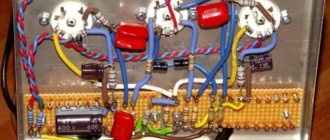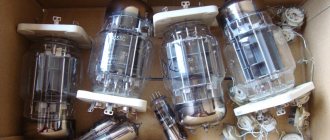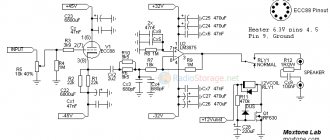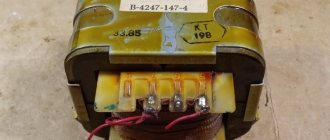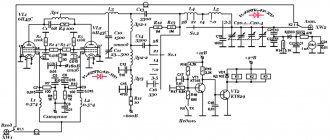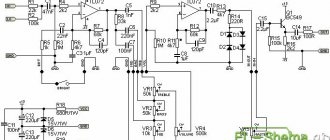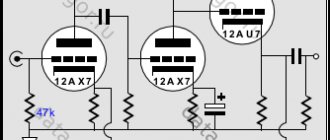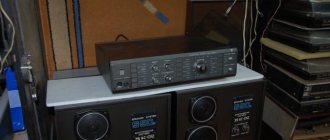Table of analogues of electronic tubes
June 30, 2022 | Maxim Ivanov
Analogues of electronic tubes. Reference Information. The list should be read like this: on the left is the lamp, after the hyphen are its analogues, listed separated by commas. Use the keyboard shortcut Ctrl+F to search the page. Source of information - www.btb-elektronik.de
12E1 - CV345 211 - VT4C, 845 328 - R200 813 - QB2/250 816 - DCG/1000G 957 - VT237 1625 - VT136 4654 - EL50 5639 - EL84 5642 - DY80 5672 - DL652 56 87 - 6463 pinout is different 5693 - 6SJ7 5696 - ZT1020 5718 - EC71 5725 - 6AS6 5726 - EAA901, 6AL5 5727 - CV4018, 2D21W 5750 - CK1929 5751 - ECC83 5847 - E180F, 404A 5886 - CK5686 5899 - EF71 5902 - EL 71 5915 — E92H 5933 — 807W 5965 — 7062 6005 — 6AQ5W, 6095 6014 - C1K 6028 - 408A 6038 - ECC91 6057 - E83CC, ECC803S 6058 - 5676, CV4025 6064 - M8083, CV4014 6074 - OB2, 108C1, STV108C30 6080 - ECC230 6082 — 6080 6101 — 6J6 6135 — 6C4W 6159 — QE05/40H 6186 — 6AG5WA 6197 - 6CL6 6201 - CV4024, ECC81 6202 - EZ90 6205 - EF734 6280 - 416B 6322 - BL25 6360 - QQV03/10 6386 - 5670 6485 - 6AH6 6678 - 6U8W 680 2 - GC10/4B 6829 - E180CC 6884 - YL1100 6922 - E88CC 6922 — E88CC 6922 — E88CC 6939 — QQE02/5 6977 — DM160 7025 — 12AX7WA 7044 — 5687 7137 — 6J4 7189 — EL84M 7289 — 2C39WA/BA 7410 — NR24 7427 — 4-408 7475 — CV188 7586 — 8056 18042 — 6086 18046 — IL861 7E6 - VT188 2E30 - 5812 10CW5 - LL86 12AL5 - HAA91 12AT7WC - E81CC 12AU7 - 6189, ECC82 12AX7 - ECC83, 5751 12AX7WA - 7025 12AY7 - 6062 12BY7 - EL180 12B Y7A - 12BV7, 12DQ7 12C5 - 12CU5 12CU5 - 12C5 12DW7 - 7247, ECC832 12EA6 - 12EK56, 12DZ6 12K8 - VT132 12SC7 - VT268 12SH1L - RV12P2000 12SX7GT - 12SN7 12Y4 - CV523 150B2 - 6354 17EW8 - HCC85 19T8 - HABC80 1A3 - DA90 1A5GT - DL31 1A7GT - DK32, VT147 1B24 - G2S 1B35 - 6038, CV369 1B3GT - DY30 1B59 - R1130B 1D7G - VR54, CV1054 1H5 (GT) - DAC32 1L4 - DF92 1LC6 - VT178 1LD5 - DAF26 1LH4 - 1B5, VT178 1N5GT - DF33 1P23 - 868 1Q5GT - DL36 1 R4 - 1294, VT183 1R5T - DK91 1S4 - DL91 1S5 — DAF91 1T4 — DF91 1U5 — DAF92 1V6 — DCF60 1X2A — DY80 1X2B — DY80 274B — Oktal 2AH2 — 2BU2 2C39A — UKW 2C40 — 6S5D, TM1 2D21 — PL21 3A4 — DL93 3A5 — DCC90 3AF 4A - 3DZ4 3B22 - EL1C 3B25 - DX2, 866 3B28 - DX2 3B4 - DL98 3B7 - 1291, VT182 3BU8 - 3GS8 3D6 - 1299, DL29, VT185 3Q4 - DL95 3Q5GT - VT221 3S4 - DL92 3T100A2 - 6V3 3V4 - DL94 4EH 7 — LF183 4EJ7 — LF184 4X150A — QEL1/150 50C5 — HL92 5814A JAN - E82CC ECC802S 5AR4 - GZ34 5D22 - 4-250 5U4G - GZ31 5V3 - 5AU4 5W4 - VT97 5Y3GT - GZ34 5Z3S - 5U4G 5Z4 - GZ30, VT74 6021W - ECC70 6146 A - QE05/40 6146B - 8298A, YL1370 6189W - E82CC 6550WE - KT88 6883B - 8032A, 8552, YL1371 6AB5 - 6N5 6AB7 - 1853, VT176 6AC7 - 6134 6AF4 - EF94 6AG5 - EF96 6AG5W - 6186 6AG6G - EL33 6AG7 - 6AK7, VT247 6AG7Y - 6AK7 6AH6 - 6485, 6SH5P 6AJ5 - 7755 6AK5 /W - EF95 6AL5 - E91AA 6AM6 - EF91 6AM8A - 19 6AQ5 - EL90, 6005 6AQ6 - EBC91 6AS6 - 7752 6AS6W - 5725W, CV4011 6AS7G - ECC230, 6080 6AT6 - EBC90 6AU4GTA - 6 CQ4 6AU6A/WA/WC - EF94, 6136 6AV6 — EBC91 6B4G — 6AU5GT 6BA6/W — 5749 6BC5 — 6CE5 6BC8 — 6BZ8 6BE3 — 6BZ3 6BE6 — EK90 6BF6 — 6BU6 6BH6 — 6661 6BJ6 — 6662 6BM5 — EL90 6BQ5 — EL84 6BQ6 — 6CU6 6BQ6GTB - 6B4G 6BQ7 - CV5365 6BQ7A - EBB180, 6BZ7A 6BR8 - 6FV8 6BZ7 - 6BQ7A 6C19C - 6S19S 6C33C-B - 6S33S-B 6C4 - EC90, 1/2 ECC82 6C41-C - 6S41S 6C5 - VT65 6CA7 - EL34 6CB6A - EF190, 6CF6 6CG7 - 6FQ7 6CH - EC90 6CL6 - 6677 6CQ4 - 6AU4GTA 6CQ6 - EF92 6CS6 - EH90 6CW4 - 7895 6D225 - EY500 6D4 - EN93 6DB6 - 6954 6DE4 - 6CQ4 6DJ8 - ECC88 6DS4 - 6CW4 6E8MG - ECH33 6EB8 - 6GN8 6F33 - CV329, CV4064 6F5G - H63 6F6G - CV731 6FQ7 - 6CG7 6G6G - VT198A 6GN8 - 6EB8 6GY6 - 6GX6 6H6G - 6H6S 6HG8 - ECF86 6J10 - 6SZ10 6J4 - CV1763 6J6/A/WA - 8532W, ECC91 6J7 - EF36, CV1937, VR56 6JE6C — 6LQ6 6K7 — VT86 6K7G — EF39, CV1941 6K8GT — CV1944 6L5G - 6C5G 6L6GC - 5881, KT66 6LJ6A - 6LH6A 6LX8 - LCF802 6N1P - ECC85 6N2P - ECC83 6N3P - ECC85 6N7 - ECC83, 6H2, 6BG6G 6P1P - EL90/6AQ5 6P45C - EL509 6P6S - 6V6GT 6S2P - 6J4 6S4P - 6Q4 6SA7 - 5961 6SJ7GT - CV591 6SJ7ST - 5693 6SK7 - 6137 6SN7 - 6H8C 6SN7 - 6H8C 6SR7 - 6G1 6SS7 - VT196 6U5 - EM34/35 6U8A - 6AX8, 6KD8, ECF82 6W6GT - 6DG 6GT 6X5GT — EZ35 6Y6 — 6U6 6Z4 — VT84, EZ91 723A/ B - 2K25 7B7 - EF22 7C4 - 1203A 829B - RS1009 832A - QQE04/20 85A1 - OE3 85A2 - OG3 8FQ7 - 6CQ7 A2134 - CV4062 A2293 - CV4079/ 1/2 6080 AC50 - 468 6 AL1 - E3a AL2/375 - 4682 CF7 - NF2 CL4 - AV1032 CV1136 - EF54, VR136 CV137 - EAC91 CV138 - EF91, 6AM6 CV188 - 7475, QS92-10 CV2127 - EL821, CV4055, 6CH6 CV2129 - 5763, QE03/10 CV2209 — CV417 CV2254 — DF60, 5678 CV2384 — ZS10C CV2434 — Z803U CV2466 — QQV02/6 CV2798 — QQV03/2 CV286 — 95A1 CV287 — 150A2 CV2886 — VT355 CV372 — 3C45 CV391 — LS650, 5B-255M CV4014 — 6064, M8083 CV4025 — E91AA, 6058 CV4064 — 6F33 CV408 — A1714 CV469 — CV4505 CV51 - EM34 CV54 - 1877 CV6189 - 417A D3a - 7721 DA90 - 1A3 DAF91 - 1S5 DAF92 - 1U5 DAF96 - 1AH5, 1FD1, 1S5T DC70 - 6375 DCC90 - 3A5 DCF60 - 1V6 DF650 - CK53 8DX DF651 - CK549DX DF66 - CK512AX DF67 - 6008 DF703 — CK5886, 5886 DF904 — 1U4 DF906 — DF668 DF91 — 1T4, 1F3 DF92 — 1L4, 1F2 DF96 — 1AF4, 1AJ4, 1F1 DF97 — 1AN5 DK91 — 1R5 DK92 — 1AC6 DK96 — 1AB6 DL652 — 5652 DL653 — 5672 DL66 — CV2288 DL71 — DL631 DL91 — 1S4 DL92 — 3S4 DL93 — 3A4 DL94 — 1P11, 3V4 DL95 — 3Q4 DL96 — 3C4, 3E5, 1P1 DLL21 — DLL25 DLL25 — DLL21 DM160 — 6977 DM70 — 1M1, 1M3 DM71 — 1N3 DQ2 - AG866A, G75/06d, 866A DQ4 - AG872A, DCG5/5000GB DQ45 - DCG7/6000 DX2 - 3B28, DCX4/1000 DY80 - 1X2A DY802 - 1BQ2 DY86 - 1S2, 1H2 E130L - 7534 E180CC - 7062 E180F - 6SH9P , 6688 E182CC — 7119 E186F — 7737 E188CC — 7308, 6922, E88CC E1C - 955, 4671 E1F - 954, 4672 E236L - EL36 E280F - 7722 E288CC - 8223 E34L - EL34 E3F - 956 E55L - 8233 E80CC - 6085 E80CF - 7643 E 80F - EF86, 4084 E80L - 6227 E80T - 6218 E810F - 7788 E81CC - 12AT7WC E81L - 6686, EL861, EL801 E82CC - 5814A E83CC - ECC803S E83F - 6689 E84L - 7320, EL84 E86C - EC806S E88C - 8255 E88CC - ECC88 E90 CC - 5920 E90F - 7693 E91AA - 5726, 6AL5W E99F - 6662 , 6BJ6A, 7694 EA50 - 2B35, 6D1, VR92, CV1092 EA76 - CV469, 6489 EAA901S - E91AA, 5726, 6AL5W EAA91 - EB91, 6AL5, CV283 EABC80 - 6T8 EAC91 - 6AQ6, CV1 37 EAF42 - 6CT7 EAM86 - 6GX8 EB34 - CV1054 EB41 — CV3881 EB91 — DAA91 EBC41 — 6CV7 EBC81 — 6BD7A EBC90 — 6AT6 EBC91 — 6AV6 EBF80 — 6N8 EBF89 — 6DC8 EBL21 — EBL71 EC1000 — 8254 EC52 — CV1137, VR137 EC53 — CV1197 EC 54 - CV66 EC55 - DET22, VC273 EC70 - CV468 EC71 - 5718, CV3930 EC80 - 6Q4 EC8010 - 8556 EC806S - E86C EC81 - 6A4 EC84 - 6AJ4 EC86 - 6CM4 EC88 - E88C, 6DL4, 8255 EC90 - 6C4W EC900 - 6HA5, 6HN5 EC91 - 6AQ4 EC92 - 6AB4, 6664 EC95 - 6ER5 EC98 - 6J4 ECC189 - 6ES8 ECC31 - 6N7G ECC70 - 6021 ECC802S - E82CC ECC803S - E83CC ECC808 - ECC83 ECC81 - 12AT7 ECC82 - 12AU7 ECC832 - 12DW7 ECC83S - 12AX7 ECC84 - 6CW7 ECC85 - 6AQ 8 ECC85/E - 6N1P ECC86 - 6GM8 ECC88 - E88CC, 6DJ8 ECC91 — 6J6, CV858, 6101 ECC99 — 300B ECF80 — 6BL8 ECF801 — 6GJ7 ECF802 — 6JB8 ECF82 — 6U8A, 6GH8 ECF86 — 6HG8 ECH200 — 6V9 ECH21 — 6V3 ECH35 — ECH33, 6E8G, CV1347 ECH81 - 6AJ8 ECH83 - 6DS8 ECH84 - 6JX8 ECL80 - 6AB8 ECL805 - 6GV8, ECL85 ECL84 - 6DX8 ECL86 - 6GW8 EF183 - 6EH7 EF184 - 6EJ7 EF22 - 7B7, CV303 EF36 - EF37A EF37A - CV5080, VR56 EF39 - CV1053 EF41 - 6CJ 5 EF43 - EF42 EF50 - VR91, ARP35, CV1091 EF54 - CV1136 , VR136 EF71 - 5899, EF731 EF732 - 5840 EF80 - 6BX6 EF800 - EF860 EF806S - 6247, EF86 EF85 - 6BY7 EF86 - 6CF8, 6BK8 EF860 - EF800 EF861 - E180F EF89 - 6DA6 EF91 - CV138, 6AM6 EF92 - 6CQ6, CV131, M8161 EF93 - 6BA6 EF94 - 6AU6WC, 6SH4P EF95 - 6AK5 EF96 - 6AG5, 6SH3P EF97 - 6ES6 EF98 - 6ET6 EH90 - 6CS6 EH900S - 5915, E91H, 6687 EH960 - EF860 EK90 - 6BE6 EL11 — EL3N EL152 — LS50/GU50 EL22 — CV304 EL3 /N - EL11 EL300 - 6FN5 EL32 - CV1052, VT52 EL33 - 6M6G EL36 - 6CM5 EL41 - 6CK5 EL5/375 - 4689 EL500 - 6GB5A EL503 - 8278 EL508 - 6KW6 EL509 - 6KG6 EL519 — 6KG6A EL6 — 4699 EL6 — 4699N EL81 — 6CJ6 EL82 - 6DY5 EL821 - 6CH6, CV2127 EL83 - 6CK6 EL84 - 6BQ5 EL84 - 6BQ5 EL86 - 6CB5 EL861 - E81L EL90 - 6BM5, 6AQ5 EL91 - 6AM5, CV136 EL95 - 6DL5 EM34 - 6E5C EM35 - 6E5C EM80 - 6BR5 EM81 - 6DA5 EM84 - 6FG6 EQ80 - 6BE7 EY500A - 6EC4A EY51 - 6X2 EY81 - 6R3 EY82 - 6N3 EY83 - 6AL3 EY86 - 6S2 EY87 - 6S2A EY88 - 6AL3 EY91 - CV135 EZ35 - 6X5GT EZ40 - 6BT4 EZ80 — 6V4, 6Z4P EZ90 — 6X4, 6BX4 EZ91 — 6Z4 , 6AV4 GN6 - Z570M GR15 - ER1 GR16 - ER21A GR17 - ER22, Z804U GR20 - ER3 GZ32 - 5AQ4, CV593, 5Y4GA, 5V4GA GZ33 - CV5745 GZ34 - 5AR4 HAA91 - 12AL5 HABC80 - 19T 8 HBC90 - 12AT6 HBC91 - 12AV6 HCC85 - 17EW8 HCH81 — 12AJ8 HF93 — 12BA6 HF94 — 12AU6, CV1961 HK90 — 12BE6 HL90 — 19AQ5 HL92 — 50C5 HL94 — 30A5 HY90 — 35W4 KL1 — VT51 LD1 — 12S3S OA2 — 150C2 OA3 — SG2S OB2 — SG2P OB3 — VR90 OC2 — 75C1 OC3 — SG3S OC3 — VR105 OD3 — SG4S OD3 — VR150 PABC80 — 9AK8 PC86 — 4CM4 PC88 — 4DL4 PC900 — 4HA5 PC97 — 4FY5 PCC189 — 7ES8 PCC84 — 7AN7 PCC85 — 6AQ8 PCC88 — 7DJ8 PCF200 — 8X9 PCF80 — 9A 8 PCF801 - 8GJ7 PCF802 - 9JW8 PCF82 - 9U8A PCF86 - 8HG8 PCH200 - 9V9 PCL805 - 18GV8A PCL82 - 16A8 PCL84 - 15DQ8 PCL85 - 18GV8 PCL86 - 14GW8 PD500 - 9ED4 PD510 - 9ED4A PF86 - 4HR8 PH100 - 2XM100 PL126 7 - OA4G, Z300T PL21 - 2D21 PL36 - 25E5 PL500 - 28GB5 PL504 - 28GB5A PL508 - 17KB6 PL509 - PL519, 40KG6 PL519 - 40KG6A PL5551A - AJ5551A, ZX1051 PL5552A - AJ5552, ZX1052 PL5684 - 6011, C3JA, 710 PL81 - 21A6 PL82 - 1 6A5 PL83 - 15A6 PL84 - 15CW5 PL95 - 16DL5 PY500A - 42EC4A PY80 - 19X2 PY82 — 19Y3 PY83 — 17Z3 PY88 — 30AE3 QB/200 — 6155 QB3/300 — RS685 QB5/1750 — SR45 QQE02/5 — 6939 QQE03/12 — 6360, RS1029 QQE03/20 — 6252, RS1019 QQE0 4/15 - 5895 QQE04/5 — 7377 QQE06/40 — 5894, RS1009 RE074t — A407 RE084 — A408 RE114 — L410 REN1104 — W4080, E438 REN704d — U4100D REN914 — W1110 REN924 — AN4092 RENS1204 — A4080D RENS12 34 - X4123 RENS1264 - H4111D RENS1274 - H4115D RENS1294 - H4129D RENS1374d - L416D /5, APP4120 RENS1823d - L2318 RES094 - H406D., H410D RG12D60 - HC1 RGN1054 - G1054 RGN1064 - G1064, CV4100, 1805 RGN354 - G354 RGN504 - G504 RGN564 - G564 RL12P35 — RS287 RS1003 — SRS551 RS1009 — 5894, QQE06/40 RS614 — RS1006, 7986 RS630 - RS1026, 5867A RS631 - RS1016, 5868 RS635 - RS1046, 7092 RS685 - RS1007, 6155 RS686 - RS1002A RS687 - 6079 STR85/5 - SG5B STV10 8/30 - OB2, CV1833 STV150/30 - 150C2, OA2 STV85/ 10 - 85A2 SV300B - 300B TT11 - CV1501 TT15 - 7842 U27 - VU111 UABC80 - 28AK8 UAF42 - 12S7 UBC41 - 14L7 UBF80 - 17C8 UBF89 - 19FL8 UC92 - 9AB4 UCC85 - 26AQ 8 UCH42 - 14K7 UCH81 - 19D8, 19AJ6 UCL82 - 50BM8 UF14 - VF14 UF41 - 12AC5 UF80 - 19BX6 UL84 - 45B5 UY41 - 31A3 UY82 - 55M3 UY85 - 38A3 VU39 - UU5, CV1039, RGN2004 Z5600M - ZM1022
Tube amplifiers. Selection of electronic tubes. Do you need it?
An article about the selection of lamps. What exactly is the problem? Why is this article needed? Why did you think about this topic? Probably because some experience has been accumulated, new knowledge has been mastered, and a transition to a new quality has occurred in understanding the problems of building tube amplifiers of objectively high quality. Most of the articles I wrote for this site are aimed at generalizing and systematizing some experience gained on the basis of the amount of knowledge and the sequence of actions for their implementation. Many of the results presented were discussed in a narrow circle of like-minded specialists. Therefore, the information I often provide is not only and not so much my position, but the consolidated position of several people, and technicians of very poor qualifications. That is why many TV viewers should take a close look at the articles and listen to the words. There will be no harm, but benefit is possible.
At the outset, the presentation adopts several postulates. And then you should ask several questions on the merits and then try to answer them, to the best of your understanding of the issues while maintaining common sense.
Statements accepted without proof.
1. In the analog audio amplification path, the highest quality is provided not by transistor, but by tube amplifiers. Amplifiers with signal sampling are not subject to consideration due to their inferiority (or prohibitive class).
2. While the most important characteristics are equal, transistors are inferior in sound amplification quality to lamps. This statement is accepted as a basis, although the results may not be recognized during expert assessment. Consequently, the concept of “quality” here has more of a subjective connotation than an objective one.
3. For a more objective, detailed assessment, it is necessary to compare the quality of tube and transistor amplifiers by instrument, ensuring the same input and output resistances, loading on the same resistive resistance. The sound source is also the same - laboratory.
4. An expert comparison of the quality of a tube and transistor amplifier cannot be performed when they are connected to the same speaker system. The acoustics should be different and, in most cases, unique. Therefore, it is possible to consider the quality of a tube amplifier separately from the quality of acoustics only conditionally.
5. During an expert assessment, the result of the research and assessment cannot be considered absolute and the only correct one. It can only be considered as a recommendation. And the significance of this recommendation should be assessed in proportion to the authority of the experts, the weight of their academic degree or public reputation.
6. The concept of an energy-efficient tube amplifier introduced in the article will be interpreted as a device that provides the highest possible quality of sound amplification while efficiently using the power consumed from the power source. The efficiency of the total anode power in the load must be at least 30%.
7. In the analog amplification path, the output vacuum tubes perform functionality similar to the output transistors in a transistor amplifier. Therefore, we will call the transistor a T-element, and the electron tube, respectively, an L-element (power element). Push-pull tube amplifiers are similar to push-pull transistors. Therefore, single-ended amplifiers cannot be considered due to their inferiority.
8. Any factors that are difficult to explain within the framework of common sense are not taken into consideration. Marketing verbal husk, located beyond a reliable quantitative assessment in Euclidean space, as well as located beyond the technical and economic efficiency of the TUBE AMPLIFIER project, is recognized as bullshit.
In the further presentation it is necessary to give relatively simple but well-founded answers, answers without fanaticism, answers to the questions posed below.
How to show that the selection of final transistors in powerful amplifiers is necessary?
Theoretically demonstrate and experimentally verify. Let's call it a powerful amplifier that has a relatively powerful power source that burns out the output transistors in the event of an unprotected short circuit or installation errors. This definition is qualitative, but it is difficult to give a quantitative one. Well, for example, 10 W or more. The peculiarity of transistors is that the semiconductor of the transistor under voltage sharply nonlinearly changes the property of transmitting electric current. Moreover, this nonlinearity is not limited by the current value. That is why, even with a slight increase in voltage, an excessive increase in current is possible, which leads to burnout of the silicon crystal inside the transistor housing. Consequently, the DC mode in the transistor amplifier must be strictly fixed. When transistors heat up, the physical properties of the semiconductor fluctuate. However, the circuit must take measures to automatically stabilize the mode at the selected operating point. Since amplifiers are designed to increase the power of an AC audio signal at a load—a loudspeaker—in addition to the DC mode, the AC transmission modes are carefully configured. In transistor technology, bipolar power supply seems to be the most advantageous. It is built in the form of two sources of small voltage, for which the supporting arms are opposite in sign. By connecting together the poles (+ and -) of different sources, they form a common power point of a single source, which is considered neutral and grounded. Then the positive pole of the bipolar source serves the circuits for the passage of positive half-waves of the audio signal. And the negative pole of a bipolar source is connected to the power circuits of elements designed to amplify negative half-waves.
The adopted division of the source into two symmetrical poles improves the independence and symmetry of the power supply of T-elements during the passage of signal half-waves and reduces overall distortion. However, the requirement of symmetrical gain becomes extremely important. That is why output stages that consume extreme currents are necessarily built from transistors selected for the current transfer coefficient. In a pile of transistors, the divergence in properties can be colossal. Tansistor crystals are produced on far from ideal production lines, where the equipment settings can be lopsided. The technology for cutting semiconductor structures in bourgeois conditions is robotic, it is many times more accurate and cleaner. That's why Toshiba, for example, makes transistors with a minimum discrepancy in parameters. But even there, differences may be present, especially between different batches of transistors. At the same time, the discrepancy in the amplification parameters of power transistors in symmetrical full-wave circuits is unacceptable. That's why we have to select T-elements. Moreover, the gain curvature is not just unsightly because it increases signal distortion. The main consequence of asymmetry is the danger of rapid curvature of the current regime due to different heating of the arms. And this is fraught with instant burnout of the overheated output T-element, and then the second one. It should be remembered that the transistor amplifier operates at low voltages in each arm (30-60V), but at high currents (10 amperes or more). It is the initially large currents that can turn out to be even larger, uncontrollably larger, due to the low internal resistance of the source. They are the ones who can burn out power transistors.
Is it necessary to select T-elements in amplifiers at all?
We need more common sense. This is an almost universal recommendation. Selection of T-elements according to parameters is needed in those critical nodes where this is necessary. The selection is certainly carried out in transistor pair designs operating in signal comparison mode. Or they use obviously symmetrical transistor pairs in such nodes. But these are low-current nodes. And the consequences of using crooked transistors here are not fatal. It’s just that the circuit will be lopsided, it will work incorrectly, or it won’t work. But if we are talking about power circuits that provide symmetrical transmission of a signal or a certain amount of energy, then the need for selection will be determined precisely by the energy (thermal) regime and its symmetry. If there is even a slight asymmetry in the parameters of the power T-elements, the overheating of one arm may be greater than the other. Thermal stabilization means may not catch the boundary, and a critical decrease in the breakdown voltage threshold can be fatal. At the same time, it is not a fact that thermal protection will work on the most overheated unit. And besides, if there are errors in design or installation, thermal stability may be completely impaired. Then irreversible consequences occur in the form of transistor burnout. Burning out of T-elements is typical for highly loaded devices. In low-power devices, this phenomenon is quite rare. In all units that do not require thermal stabilization, selection of elements is not necessary. It is only important to ensure sufficient static gain of the crystal for the operation of the transistor in a specific circuit at a specific location.
How to prove that the structure of the power supply circuit of a tube amplifier is significantly different from a transistor amplifier?
Just look at the typical diagrams. Having basic analysis skills, try to understand the circuitry of a tube amplifier, because it is banal. In the picture of the circuit of almost any tube amplifier there is only one positive pole of the power supply. The second pole is the single negative pole, also known as the earth. Electric current conditionally follows from plus to minus, doing work along the way. Since audio signals are alternating in sign, their processing requires the presence of some conditionally positive and conditionally negative arms in the circuit. Between them is the zero (neutral) point for the alternating signal. This neutral current is located somewhere in the middle between the positive and negative poles of the power source. Each such arm is served by its own push-pull cascade lamp. In a traditional transformer tube circuit, ground is connected to the negative pole of the power supply. But for an alternating electrical signal, this “ground” is not a neutral point. The signal zero is isolated from ground and floats between the positive pole of the power supply and ground. Zero DC potential and zero AC potential are never the same in a traditional tube circuit. In a transistor circuit with bipolar power supply, there is only one zero potential and it is the same for direct current and alternating current modes.
Any discussion of the problem of symmetry (selection) of lamps should be carried out only in the key of ensuring high quality signal amplification, and the emphasis should be placed primarily on energy-efficient amplifiers. It must be remembered that up to 50% of the amplifier's power is consumed by filament circuits. The rest is spent on heating through power circuits, including anodes, and is also taken into the load. That is why for amplifiers with an equivalent efficiency of 5-10%, discussing the topic of selecting the parameters of output lamps is generally MEANINGLESS !
How to prove that the power supply mode of a tube amplifier is significantly different from a transistor amplifier?
It is enough to apply Ohm's law. The tube amplifier has quite high voltages (positive pole) intended for anode supply. And since the output powers of tube amplifiers are not large, the currents consumed from the power supply are also relatively small. The currents consumed from the source are tens or hundreds of milliamps. And since the currents are small, then there is no reason for the power elements to burn out. When the voltages are huge and the currents are small, then the internal resistance of the power supply is high. The risk of damage to power elements is minimal.
The fact is that, despite all the banality of the skeleton of a tube amplifier, a properly designed circuit fully meets the requirement of automatic gain balancing with a monstrous spread in the parameters of the output tubes. Moreover, selecting 20-30% of the anode power of output lamps into the load is absolutely safe, even for lamps that have the worst reputation in terms of thermal stability. Therefore, without any selection of tubes in a simple tube amplifier, it is simply easy to ensure safe operating conditions. It is only necessary to ensure thermal stability conditions. And there is no need to overload such an amplifier. For example, 10 Watts of power taken into the load from almost any push-pull amplifier is absolutely safe. And the power of 10 W transmitted to highly sensitive acoustics is not so little. In addition, with the correct setting of the quiescent current, the spread of lamp parameters will not cause any noticeable distortion at all. And it is precisely the features of lamp circuitry that are the reason for this. So why then give greedy capitalists hundreds of their own green money for an unnecessary selection of output vacuum tubes?
Why are output stage lamps selected according to parameters preferable?
The answer to this question depends on the level of the creator’s claims, and mainly to himself. What has been said is easy to explain. The level of demand and ambition of a person is a priority here. Since there is no urgent need to select lamps for a medium-power amplifier, for example, internal culture or excessive ambition can force you to select them. These are SUBJECTIVE motives. But all this is reasonable if you have enough resources (light bulbs and time), as well as the availability of equipment. Selected bulbs make it easier to tune the amplifier, since voltages and currents are easier to balance. Setting up an amplifier with symmetrical lamps is more comfortable, the result of tuning an amplifier with a highly symmetrical transformer is more accurate, and the sound of a LUMZCH with selected lamps is more beautiful. Limit operating modes and horsepower are almost always available. If there is interest and the ability to regulate the power source, it is possible to drive the lamps to the limiting modes and even exceed them. At the same time, the operation of the amplifier remains stable, and the quality is exceptionally high. Achieving high energy efficiency indicators of a tube amplifier, there is an OBJECTIVE motive for increasing labor costs or investments in the selection of lamps for the output push-pull stage, this is the preference.
In what case and for what reasons can the selection of output amplification elements be ignored?
With low demands on the result, many processes can be simplified. This applies not only to hardware. In most cases, under the front facade of imported siding hides a poor structure made of sleepers or crooked bricks and concrete pouring. If the amplifier contains sufficiently powerful tubes and a large transformer, but it is not planned to use the tube amplifier in extreme modes, if the budget of the project for the manufacture of a tube amplifier is limited for reasons of common sense, and not poverty, if a person’s exactingness does not go beyond the limits of the same common sense, then the selection of output lamps can be neglected. If the “Tube Amplifier” project is intended to be cheap and devoid of show-offs, then the selection of output tubes can also be ignored.
In what case is it vital to select the parameters of the output power elements of a tube amplifier?
The selection of output tubes of a push-pull stage is vital if long-term operation of the amplifier in extreme conditions is inevitable. This is a mandatory technical limitation. There may be another important limitation, for example a marketing one. If the product is planned to be sold for a lot of money, green pieces of paper or wood, then the output stage lamps must certainly be selected. The cost of the product should not include only show-off or 90% of the capitalization of a famous Brand. The cost of a quality product should include the cost of components, intellectual and real labor costs, estimated according to the standard hours of the developer and his qualifications. A balanced assessment of the listed components cannot bring the cost of any tube amplifier into the realm of crazy numbers, located above 100 thousand wooden money. The cost of such hardware of modern or vintage announcement (vintage-junk), positioned from 500 thousand rubles, is bestiality. It is the numbers indicated in the text that should be regarded as an indicator of going beyond the bounds of common sense. If people who consider themselves elite are willing to pay that kind of money for such products, then that’s their problem. In Russia, the elite was long ago and practically exterminated by the Bolsheviks. What claims to be called “elite” now is mostly crap. Foreign elite with specific surnames such as Rockefellers, Rothschilds, Warburgs, etc. these are ordinary smart bandits, grouped into an invisible power based on financial and national characteristics. For me they are equal to Meir Lansky and Lepka Buchalter, only legalized. In connection with the above, there is no need to have any dealings with persons, companies and families operating similar products and amounts greater than those indicated in peacetime. At other times, for example at the stage of a social revolution, it would be quite reasonable to gut them.
How to prove that tube UMZCHs are more resistant to damage due to mode deviations?
This can be justified simply. Sometimes it is enough for an inquisitive TV viewer to pick up a glass container of an electron tube. It will immediately become clear that all the interelectrode gaps are not filled with silicon at all. Vacuum between electrodes. There are no molecules or atoms inside the flask, no gas, no conducting substance. And if not, then all the spaces between the electrodes have the maximum possible insulation. And the flow of electrons is controlled by an electric field. The electric field is volts divided by meters. Meters are constant, so adjusting the voltage across the lamp is adjusting the current through the lamp. By strictly limiting the voltage on the lamp, as well as using automatic means of controlling and maintaining voltages within specified limits, you can protect the lamp from excessive increases in current. There is no semiconductor material in the lamp, therefore there are no uncontrolled reactions of its conductivity caused by overheating of the material. And besides, with a relatively high supply voltage, there are quite small consumption currents. Therefore, the internal resistance of the power supply is quite high. This means that even in extreme conditions, the internal resistance of the power supply can serve as a real limit to the uncontrolled increase in current. Namely, current is the cause of failure of the power elements of the output stage.
Why should information about the identity of the operating parameters of L-elements from the same batch be considered a myth?
The answer to this question is a statement based on many years of experience and a significant amount of time spent searching for the answer. It is this time in his life that an intelligent person can save and free up for more interesting and useful activities. Conveyor light bulb production technology. But the accuracy of placing electrodes and placing the insides of light bulbs largely depends on human hands. As it turns out, it is quite difficult to find identical copies inside a sealed box of light bulbs. Based on the results of sorting glass cylinders from many boxes, we can confidently conclude that for light bulbs the spread of parameters is somewhat smaller than for transistors. Apparently the machines and equipment of the conveyor production for lamps are not particularly well set up, perhaps they are in a dilapidated condition. However, so does equipment for cutting semiconductor crystals. The result of many hours of practical work on selecting lamp pairs was literally unsuccessful. The phrase “lamp from the same batch” is an ordinary marketing trick. This is an advertising slogan designed to justify increasing the cost of a product sold to a low-skilled public. This is more of a temptation for amateurs. I assert with complete responsibility that lamps from one batch of Sovdep copies have a relatively large spread of parameters, for example 50%. However, it is less than that of Soviet transistors from the same batch, which can actually be 500%. The fact is that the parameters of “ordinary” transistors can easily differ by a factor of 10. Therefore, the determining factor is the measure factor. Anyone who knows the details about the difference between the use of transistors and the use of lamps will understand what kind of morons this advertising slogan is aimed at.
Measurements of several batches of the most common types of lamps showed that a spread in anode currents of 30-40% is the norm. In this case, the slope and currents along the second grid turn out to be very different. Therefore, achieving identical parameters within 10% of 30-40 lamps is simply not realistic. Even if there are a hundred pieces of the same type of glass cylinders, then for reasons of common sense you just need to moderate your appetite and limit yourself to 20%. In most cases this is quite enough. The approach of purchasing hundreds of light bulbs in order to select two pairs in the 5-10 percent range will be too expensive. And this is if you don’t value your time. There is one obvious advantage to practically sorting through a bunch of Soviet lamps. It consists in the possibility of rejecting up to 10% of lamps for reasons of banal faults, broken filament circuits, depressurized cylinders and banal loss of stability. Another up to 10% of lamps can be rejected due to an unacceptable level of cathode-heat insulation. But the remaining lamps will be quite within the framework of proving the thesis about their bold use in structures of average quality and energy efficiency. A spread of parameters of 40% is quite suitable for building a normal tube amplifier. Moreover, a significant part of the curvature in a push-pull amplifier can be straightened during tuning and balancing.
At the same time, for clients with an increased level of demands, the condition for a relatively accurate selection of lamps can be met by increasing the amount of resources involved and labor costs. This may well serve as a basis for increasing the price tag of the product when selling it. But here you will have to really strain your eloquence and invest in advertising. Therefore, the resulting income may turn out to be very modest, since part of the money will simply be given to network merchants. And stimulating this industry is a great sin.
How can the problem of selecting the parameters of output L-elements in a tube amplifier be circumvented?
Quite simple. Weigh the extent of necessity and discard show-offs. More common sense is needed everywhere. You just need to reduce the level of demands. This will allow you to use low-power push-pull amplifiers without any selection of tubes, without worrying about operating modes and without any significant deterioration in sound quality. One of the radical solutions is a conscious transition to the use of low-power single-ended tube amplifiers. For single-cycle LUMZCH this problem does not exist in principle.
Why should purchasing matched pairs of L-elements for a high-fidelity amplifier be considered preferable to selecting them yourself?
Life experience may again provide the answer. The test results showed that from a box of lamps (50-100 pcs) you can select two or three pairs in a couple of days. But you first need to buy a hundred light bulbs, and the device is not easy to get or make, even to borrow or rent. With a cheap purchase, 100 lamps = 3000-5000 rubles. A normal device = 9000-10000 rubles, plus the time spent. You can try to conclude: If you can buy a guaranteed matched pair for 1000 wooden money, then this is quite profitable. But buying a pair of EL-34s from an “imported vacuum” for 10 thousand wooden money is already stopping me. The fact is that it is quite problematic to recoup such investments in glass in the future. The population of this rich country is quite poor, and purchasing power is not high. You can agree with the comedian that our Motherland is wonderful, but our state is monstrous. Experience shows that accumulating inventories is not particularly profitable and is quite expensive. Therefore, everyone solves this problem on their own. I can only recommend taking a short and direct route to your goal.
Well, at the end of the article, a few words should be said about fools. First of all, this concerns lovers of imported vacuums, examples of which are shown below. The level of price claims of the manufacturers of this glass is designed specifically for morons. And it’s sad that there are still quite a lot of such morons on our land. Once again I repeat that gilded letters printed on glass are not worth the money as written below, even wooden rubles.
If you simply stole the money you carry in your pockets, then you can buy this shit. Just keep in mind that in this case you are simply changing places with the one you recently screwed up. In our case, they openly and shamelessly “have” you. By the way, high-quality Sovdepov copies of similar lamps, quite suitable for operation of a tube amplifier, cost 20-50 times less. The characteristics of Soviet tubes may differ slightly, but the result of their use in a normally assembled and tuned amplifier will be excellent, and no one will ever notice the differences in sound, since there are none :)))
The information presented is a gift, I’m giving it away for free, value your time, don’t waste your life in vain. When reading the texts on this site, just try to understand that time is much more valuable than money. Time flies irreversibly, and money in most cases is just paper. Less often, money makes it possible to satisfy some need. It’s worse when money becomes a means of satisfying stupid ambition. There are even worse, more evil examples of the use of money. And time cannot be crafty or mean.
Evgeniy Bornik, Krasnoyarsk, Russia, May 2016
